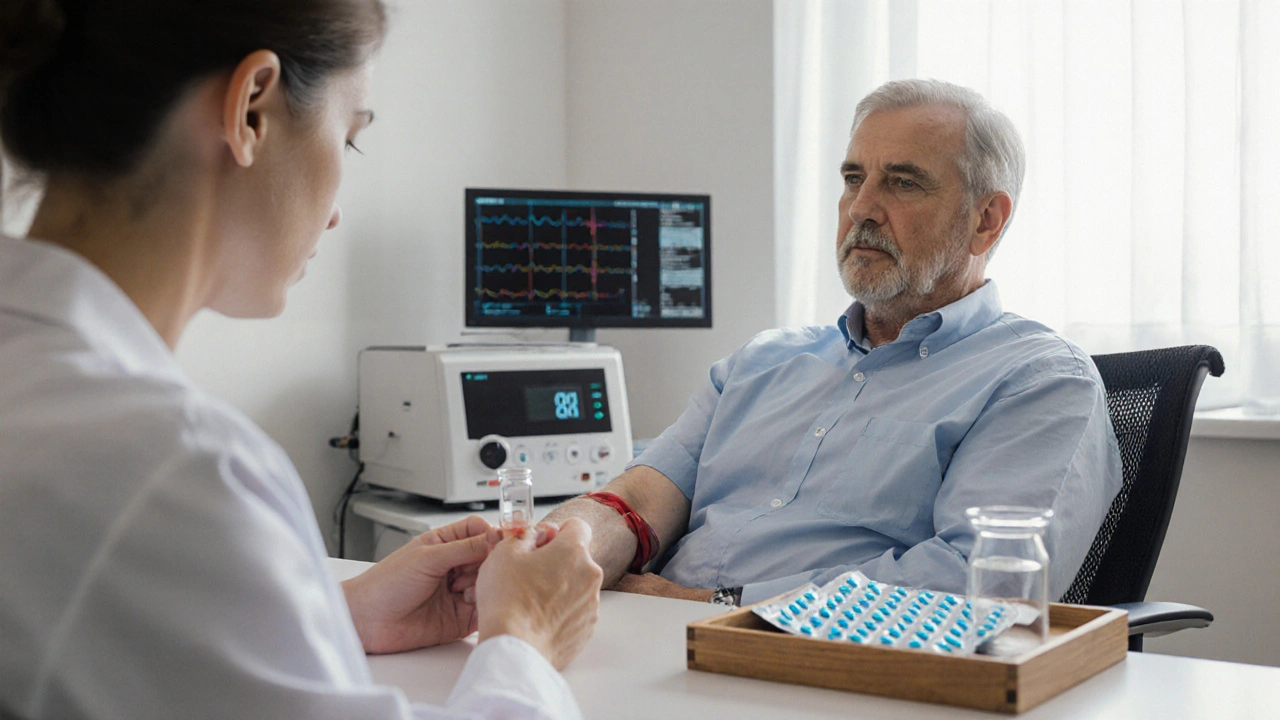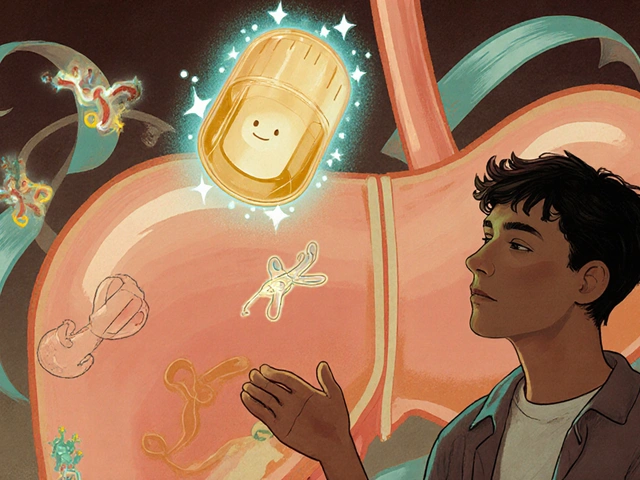Antipsychotic Comparison Tool
Use this tool to compare the key characteristics of Clozapine and other antipsychotics used in treating schizophrenia. Select a drug to see detailed information.
Select a drug from above to view its detailed comparison information.
| Drug | Efficacy in TRS | Major Side Effects | Monitoring Required |
|---|---|---|---|
| Clozapine | High | Agranulocytosis, metabolic syndrome, seizures, constipation | Weekly CBC ×6 months |
| Olanzapine | Moderate | Weight gain, diabetes, dyslipidemia | Metabolic panels every 3 months |
| Risperidone | Moderate | Prolactin elevation, mild EPS | Prolactin check if symptoms appear |
| Quetiapine | Low-moderate | Sedation, orthostatic hypotension | Blood pressure monitoring initially |
| Haloperidol | Low in TRS | High EPS, tardive dyskinesia | Movement disorder assessment regularly |
Key Takeaways
- Clozapine remains the most effective option for treatment‑resistant schizophrenia, but it demands strict blood monitoring.
- Olanzapine offers strong symptom control with a higher risk of weight gain and metabolic issues.
- Risperidone balances efficacy and side‑effect profile but can raise prolactin levels.
- Quetiapine is useful for patients needing sedation, yet its antipsychotic potency is modest.
- Haloperidol, a typical antipsychotic, works well for acute agitation but brings a high chance of movement disorders.
Imagine a medication that can turn life around for people whose psychosis doesn’t respond to anything else-then picture the daily blood tests, the strict diet watch, and the constant vigilance for rare but serious side effects. That’s the reality of Clozapine is an atypical antipsychotic reserved for treatment‑resistant schizophrenia (TRS) and known for its powerful efficacy and stringent safety monitoring. If you’ve ever wondered how it measures up against other drugs on the market, you’re about to get a clear, side‑by‑side look.
Understanding Clozapine and When It’s Used
Schizophrenia is a chronic brain disorder marked by hallucinations, delusions, disorganized thinking, and reduced emotional expression. Most patients improve with first‑line antipsychotics, yet roughly 30% experience treatment‑resistant schizophrenia (TRS), defined as failure to respond adequately to at least two different antipsychotics at therapeutic doses.
For those with TRS, Clozapine is the gold standard. Clinical trials show remission rates up to 60% where other drugs stall. The catch? It can trigger agranulocytosis, a dangerous drop in white blood cells (< 500 neutrophils/µL). To catch this early, patients undergo weekly complete blood counts for the first six months, then bi‑weekly or monthly thereafter.

How Clozapine Stands Apart
Beyond efficacy, Clozapine’s side‑effect profile is unique:
- Agranulocytosis - less than 1% of patients; requires vigilant monitoring.
- Weight gain and metabolic syndrome - about 30% develop significant increases in BMI, fasting glucose, or lipids.
- Seizures - risk rises with doses >600mg/day; prophylactic antiepileptics may be considered.
- Constipation - can be severe; patients need dietary fiber and possibly laxatives.
Because of these factors, many clinicians reserve Clozapine for patients who truly need it, ensuring the benefits outweigh the monitoring burden.
Popular Alternatives: Quick Overview
If Clozapine isn’t an option-whether due to contraindications, patient preference, or resource limits-several other antipsychotics come into play.
Olanzapine is an atypical antipsychotic with strong dopamine and serotonin blockade, offering robust symptom control but notable weight gain and metabolic side effects.
Risperidone is an atypical antipsychotic that balances dopamine antagonism with serotonin activity, effective for many patients but may elevate prolactin levels.
Quetiapine is a sedating atypical antipsychotic useful for patients with insomnia or anxiety, though its potency for positive psychotic symptoms is moderate.
Haloperidol is a typical antipsychotic with strong dopamine D2 antagonism, excellent for acute agitation but high risk of extrapyramidal symptoms (EPS).
Head‑to‑Head Comparison
| Drug | Typical Use | Efficacy in TRS | Major Side‑Effect Risks | Monitoring Needed |
|---|---|---|---|---|
| Clozapine | TRS, severe mania | High - remission up to 60% | Agranulocytosis, metabolic syndrome, seizures, constipation | Weekly CBC ×6months, then bi‑weekly/monthly |
| Olanzapine | First‑line, bipolar mania | Moderate - improves symptoms but less in TRS | Weight gain, diabetes, dyslipidemia | Metabolic panels every 3months |
| Risperidone | Schizophrenia, irritability in autism | Moderate - good for positive symptoms | Prolactin elevation, mild EPS | Prolactin check if symptoms appear |
| Quetiapine | Sleep disturbance, bipolar depression | Low‑moderate - less robust for TRS | Sedation, orthostatic hypotension | Blood pressure monitoring initially |
| Haloperidol | Acute agitation, psychotic emergency | Low in TRS - primarily symptom suppression | High EPS, tardive dyskinesia | Movement disorder assessment regularly |

Choosing the Right Drug: Factors to Consider
Deciding between Clozapine and its alternatives isn’t a simple tick‑box exercise. Here are the practical lenses clinicians use:
- Severity and history: If a patient has failed two adequate trials, Clozapine climbs to the top of the list.
- Medical comorbidities: Diabetes, obesity, or cardiac disease tip the scale toward drugs with lower metabolic impact, such as Risperidone.
- Patient lifestyle: Weekly blood draws require reliable transportation and a supportive network. If that’s missing, an alternative may be safer.
- Side‑effect tolerance: Some patients fear weight gain; others dread movement problems. Align drug choice with personal concerns.
- Cost and access: Clozapine monitoring programs can be pricey. Insurance coverage and pharmacy availability matter.
By weighing these dimensions, clinicians can personalize therapy rather than relying on a one‑size‑fits‑all rule.
Practical Tips for Managing Side Effects
Regardless of the drug, side effects can derail treatment. Below are actionable steps for the most common issues:
- Weight gain / metabolic syndrome: Offer a dietitian referral, encourage regular aerobic activity, and schedule fasting glucose and lipid panels every 3months.
- Prolactin elevation: Switch to a prolactin‑sparing agent (e.g., aripiprazole) if menstrual irregularities or galactorrhea arise.
- Extrapyramidal symptoms: Use low‑dose anticholinergics like benztropine, or consider a dose reduction.
- Constipation (Clozapine): Increase fiber intake, hydrate, and prescribe a stool softener early.
- Seizure risk (Clozapine): Keep doses under 600mg/day when possible; add valproate prophylactically if seizure history exists.
Open communication is key-regular check‑ins give patients a chance to flag issues before they become crises.
Frequently Asked Questions
Why is Clozapine considered the best choice for treatment‑resistant schizophrenia?
Multiple randomized trials have shown that Clozapine produces remission in up to 60% of patients who have not improved on two other antipsychotics, making it the only drug with a proven superiority in this hard‑to‑treat group.
Can I switch from Clozapine to another antipsychotic if side effects become intolerable?
Yes. A gradual cross‑taper over 2-4 weeks is recommended to avoid relapse. During the switch, continue CBC monitoring until the new drug is stable, then discontinue weekly checks if the new medication doesn’t carry an agranulocytosis risk.
How often do I need blood tests while on Clozapine?
The standard protocol is weekly complete blood counts for the first six months, then every two weeks for the next six months, and finally monthly for the remainder of treatment, provided counts remain stable.
Is Olanzapine a safe alternative for patients worried about blood monitoring?
Olanzapine does not require routine blood counts, but it carries a high likelihood of weight gain and metabolic changes. Regular metabolic screening is still essential.
What should I do if my CBC drops below the safe threshold?
Immediately stop Clozapine and contact a healthcare provider. A backup antipsychotic should be initiated, and the patient must be monitored for infection until neutrophil counts recover.






Joe Evans
Great summary of Clozapine’s pros and cons!!! 😊
Colin Boyd
While the table is visually appealing it glosses over the nuanced pharmacodynamics that truly differentiate these agents.
John Petter
One must appreciate the scholarly effort; however, the discussion lacks depth in mechanistic insight.
Annie Tian
Indeed, the overview is solid, yet we can expand on metabolic monitoring-regular labs are essential for patient safety!!!
April Knof
The comparison nicely reflects global prescribing trends, highlighting how different health systems prioritize safety versus efficacy.
Tina Johnson
Actually, the cost implications of weekly CBCs are often understated; many clinics lack resources to sustain such monitoring without compromising care.
Sharon Cohen
It’s curious how the narrative glorifies Clozapine while sidelining the very real burden of its side‑effect profile.
Rebecca Mikell
I agree that patient preference should steer the choice, especially when weighing weight gain against efficacy.
Ellie Hartman
Let’s remember to involve families in the monitoring plan; their support can make a big difference in adherence.
Alyssa Griffiths
One must also consider that some pharmaceutical lobbyists may downplay the risks of newer atypicals!!! Is the data truly unbiased???
Jason Divinity
From a linguistic standpoint, the article maintains commendable syntactic structure; however, it occasionally misuses the term “remission” where “reduction” would be more precise.
andrew parsons
It is imperative that the authors employ consistent terminology-“treatment‑resistant” should be hyphenated throughout!!! 📚
Sarah Arnold
When considering Clozapine versus the other antipsychotics, the first priority is always the patient’s clinical history and prior treatment failures. Evidence consistently shows that Clozapine yields the highest remission rates in true treatment‑resistant schizophrenia, often surpassing 60% when properly monitored. However, this benefit comes with a non‑negotiable monitoring schedule: weekly complete blood counts for the first six months, followed by bi‑weekly or monthly tests thereafter. Failure to adhere to this protocol can result in life‑threatening agranulocytosis, which underlines the necessity of a reliable healthcare infrastructure. Compared to Olanzapine, which demands metabolic panels every three months, Clozapine’s hematologic surveillance is more intensive but arguably more critical. Weight gain and metabolic syndrome remain concerns across most atypicals, yet Clozapine’s risk can be mitigated with early dietary counseling and regular lipid checks. Seizure risk, especially at doses exceeding 600 mg/day, should prompt clinicians to consider prophylactic antiepileptics in susceptible patients. Constipation, often overlooked, can become severe; proactive stool softeners and fiber supplementation are advisable from the outset. For patients with comorbid diabetes or cardiovascular disease, the metabolic profile of Olanzapine or Risperidone may be preferable, provided they have tolerated earlier trials. Haloperidol, while effective for acute agitation, carries a high EPS burden, making it unsuitable for long‑term management in most cases. Quetiapine’s sedative properties can be useful for insomnia but its antipsychotic potency is modest, limiting its role in TRS. Ultimately, the decision matrix should weigh efficacy, side‑effect tolerability, monitoring capacity, and patient lifestyle. Engaging patients in shared decision‑making improves adherence to both medication and monitoring schedules. Regular interdisciplinary meetings-psychiatrists, primary care, pharmacists-can streamline the process and catch adverse events early. Finally, insurance coverage and access to monitoring facilities often dictate real‑world feasibility; clinicians must navigate these practicalities proactively. 😊
Rajat Sangroy
Remember, if you’re starting Clozapine, ramp up the dose slowly and keep a seizure threshold checklist handy-don’t wait for a crisis!
dany prayogo
Oh sure, let’s all jump on the Clozapine bandwagon without questioning the monumental logistical nightmare of weekly blood draws-because who doesn’t love sitting in a lab every Thursday!? The article conveniently omits the reality that many patients simply can’t maintain such a regimen, leading to non‑compliance and, surprise, relapse. And while we’re at it, why not ignore the metabolic avalanche that follows Olanzapine, too? Bottom line: no drug is a panacea, and the “one‑size‑fits‑all” narrative is as outdated as paper charts!!!
Wilda Prima Putri
True, every choice has trade‑offs, and the best plan is the one the patient can actually stick to.
Edd Dan
i think it's important to balance the pros and cons of each med while keeping an eye on the patient's unique needs.
Cierra Nakakura
Stay positive! 😊 Clozapine can be a game‑changer when everything aligns, and you’ve got a solid support team behind you.
Sharif Ahmed
In the grand tapestry of psychopharmacology, Clozapine occupies a singular, almost mythic, stratum-its efficacy dwarfs the pedestrian efficacy of its peers.
Charlie Crabtree
Don’t get discouraged-find the right med, stick with the monitoring, and you’ll see improvements sooner than you think! 🚀